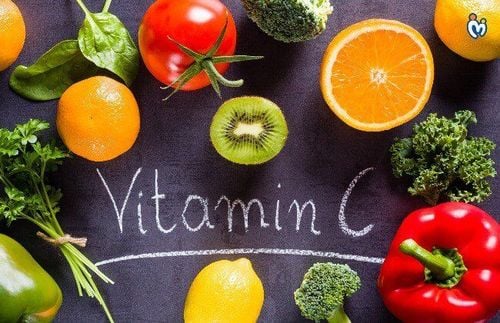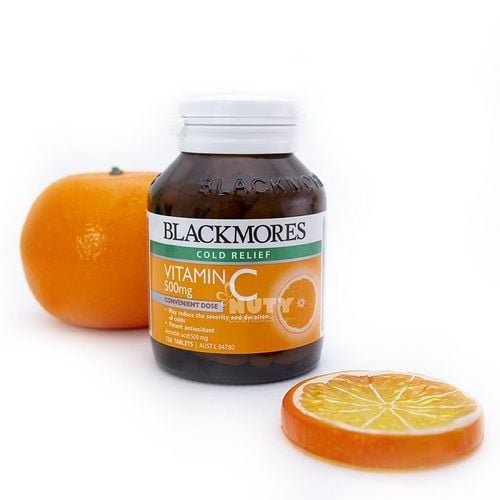This is an automatically translated article.
Vitamin C is one of the essential vitamins for the body, which acts as an antioxidant, anti-inflammatory and rebuilds collagen. The recommended amount of vitamin C will depend on your age, gender, and medical conditions. The article will provide more useful information about this nutrient.1. Vitamin C
Vitamin C, also known as ascorbic acid, is a water-soluble nutrient found in some foods. In the body, vitamin C acts as an antioxidant, helping to protect cells from damage caused by free radicals. Free radicals are compounds that are formed when our bodies convert the food we eat into energy.In addition, humans are also exposed to free radicals in the environment from cigarette smoke, air pollution and ultraviolet rays from the sun. So the body also needs vitamin C to make collagen, a protein needed to help wounds heal. Plus, vitamin C improves the absorption of iron from plant-based foods and helps the immune system work properly to protect the body from disease.
2. Vitamin C Requirement
The recommended daily vitamin requirements will depend on age and gender. In addition, the vitamin C requirements of pregnant women are also different from those of normal subjects. The average daily recommended vitamin C requirements are as follows:Newborn to 6 months: 40 mg Infants 7-12 months: 50 mg Children 1–3 years: 15 mg Children 4-8 years: 25 mg Children 9–13 years old: 45 mg Adolescents 14–18 years old (boys): 75 mg Adolescents 14–18 years old (girls): 65 mg Adults (men): 90 mg Adults adult (women): 75 mg Pregnant adolescents: 80 mg Pregnant women: 85 mg Lactating adolescents: 115 mg Lactating women: 120 mg
3. Foods that provide vitamin C
Fruits and vegetables are the best sources of vitamin C. You can get the recommended amount of vitamin C by eating a variety of foods including:Citrus fruits (such as: Oranges and grapefruit) and their juices, as well as red and green peppers and oranges. kiwi, is high in vitamin C. Other fruits and vegetables — such as broccoli, strawberries, cantaloupe, baked potatoes, and tomatoes — also have vitamin C. Certain foods and drinks fortified with vitamin C. To see if vitamin C has been added to a food product, check the product label. Vitamin C content in foods can be reduced with long storage and cooking. Steaming or microwave cooking can reduce vitamin C loss during cooking.

Các loại trái cây họ cam quýt như cam, bưởi rất giàu vitamin C
4. Food supplement with vitamin C
Most multivitamins contain vitamin C. Vitamin C is also available alone as a supplement or in combination with other nutrients. Vitamin C in dietary supplements is usually in the form of ascorbic acid, but some supplements come in other forms, such as: sodium ascorbate, calcium ascorbate, other mineral ascorbate, and ascorbic acid with bioflavonoids.5. How do you know if your body is getting enough vitamin C?
Most people in the United States get enough vitamin C from foods and drinks. However, certain groups of people have difficulty getting enough vitamin C:Smokers and those exposed to secondhand smoke, partly because secondhand smoke increases the amount of vitamin C the body needs to repair Repair the damage caused by free radicals. Smokers who need a lot more use 35 mg of vitamin C per day than non-smokers. Infants are fed boiled or evaporated cow's milk, as cow's milk has very little vitamin C and heat can destroy vitamin C. Cow's milk should not be given to babies under 1 year of age. Breast milk and formula contain the recommended amount of vitamin C. People who eat very limited variety of foods. People with certain medical conditions such as severe malabsorption, certain types of cancer, and kidney disease need hemodialysis.
6. What happens if I don't get enough vitamin C?
Vitamin C deficiency is rare in the United States and Canada. People who get little or no vitamin C (less than about 10 mg per day) for weeks can develop scurvy. Symptoms of scurvy include: Fatigue, gingivitis, small red or purple spots on the skin, joint pain, poor wound healing, and spiral hairs. Other signs of scurvy include: Depression as well as swollen, bleeding gums and loose or missing teeth. People with scurvy can also develop anemia. Scurvy can be fatal if it is not treated.
Thiếu vitamin C có thể gây bệnh scorbut với những triệu chứng như mệt mỏi, viêm nướu răng,...
7. Health benefits of vitamin C
Scientists are studying vitamin C to understand how it affects health. Here are some examples of what this study has shown.7.1. Cancer prevention and treatment People who get a lot of vitamin C from fruits and vegetables have a reduced risk of many types of cancer, such as: lung cancer, breast cancer and colon cancer. However, taking vitamin C supplements doesn't seem to protect people from cancer.
It is not clear whether taking high doses of vitamin C is useful as a cancer treatment, but the effects of vitamin C seem to depend on how it is given to the patient. Oral doses of vitamin C cannot increase blood levels of vitamin C nearly as high as intravenous doses. Several animal and test-tube studies have shown that very high blood levels of vitamin C can shrink tumors. But more research is still needed to determine whether high-dose intravenous vitamin C helps treat cancer in humans.
Supplements with vitamin C and other antioxidants may interact with cancer chemotherapy and radiation. People being treated for cancer should talk to their oncologist before taking vitamin C or other antioxidant supplements, especially when the supplement will use high amounts.
7.2. Prevention of cardiovascular disease People who eat a lot of fruits and vegetables seem to have a lower risk of cardiovascular disease. The researchers believe that the antioxidant content of these foods may be partly responsible for this link because oxidative damage is a major cause of cardiovascular disease. However, scientists aren't sure if vitamin C itself, from foods or supplements, helps protect people from cardiovascular disease. At the same time, they are not clear whether vitamin C helps prevent cardiovascular disease from getting worse in people who already have it.

Chưa có nghiên cứu nào khẳng định việc bổ sung vitamin C có thể phòng ngừa bệnh tim mạch
In a mid-study study performed in older adults with AMD at high risk of developing advanced AMD, who took a daily supplement with 500 mg of vitamin C, 80 mg of zinc, 400 IU of vitamin E, 15 mg of beta-carotene and 2 mg of copper over about 6 years have a lower chance of developing AMD.
However, the relationship between vitamin C and cataract formation is unclear. Some studies show that people who get more vitamin C from foods have a lower risk of developing cataracts. But further research is still needed to clarify this association and determine whether vitamin C supplementation affects the risk of cataracts.
7.4. Flu Although vitamin C has long been a popular remedy for the common cold, research shows that for most people, taking a vitamin C supplement does not reduce the risk of catching the common cold. . However, people who take vitamin C supplements regularly may experience fewer colds or milder symptoms when they have a cold. Using vitamin C supplements after cold symptoms start doesn't seem to help.
7.5. Effects of Vitamin C Taking too much vitamin C can cause diarrhea, nausea, and stomach cramps. However, in cases of iron overload, which causes the body to store too much iron, high doses of vitamin C can aggravate iron retention and damage body tissues. Daily vitamin C limit:
Children 1–3 years old: 400 mg Children 4-8 years old: 650 mg Children 9–13 years old: 1,200 mg Adolescents 14–18 years old:i 1,800 mg Adults : 2,000 mg For more advice on using vitamin C suitable for your body, you can contact Vinmec health system nationwide.
Please dial HOTLINE for more information or register for an appointment HERE. Download MyVinmec app to make appointments faster and to manage your bookings easily.













